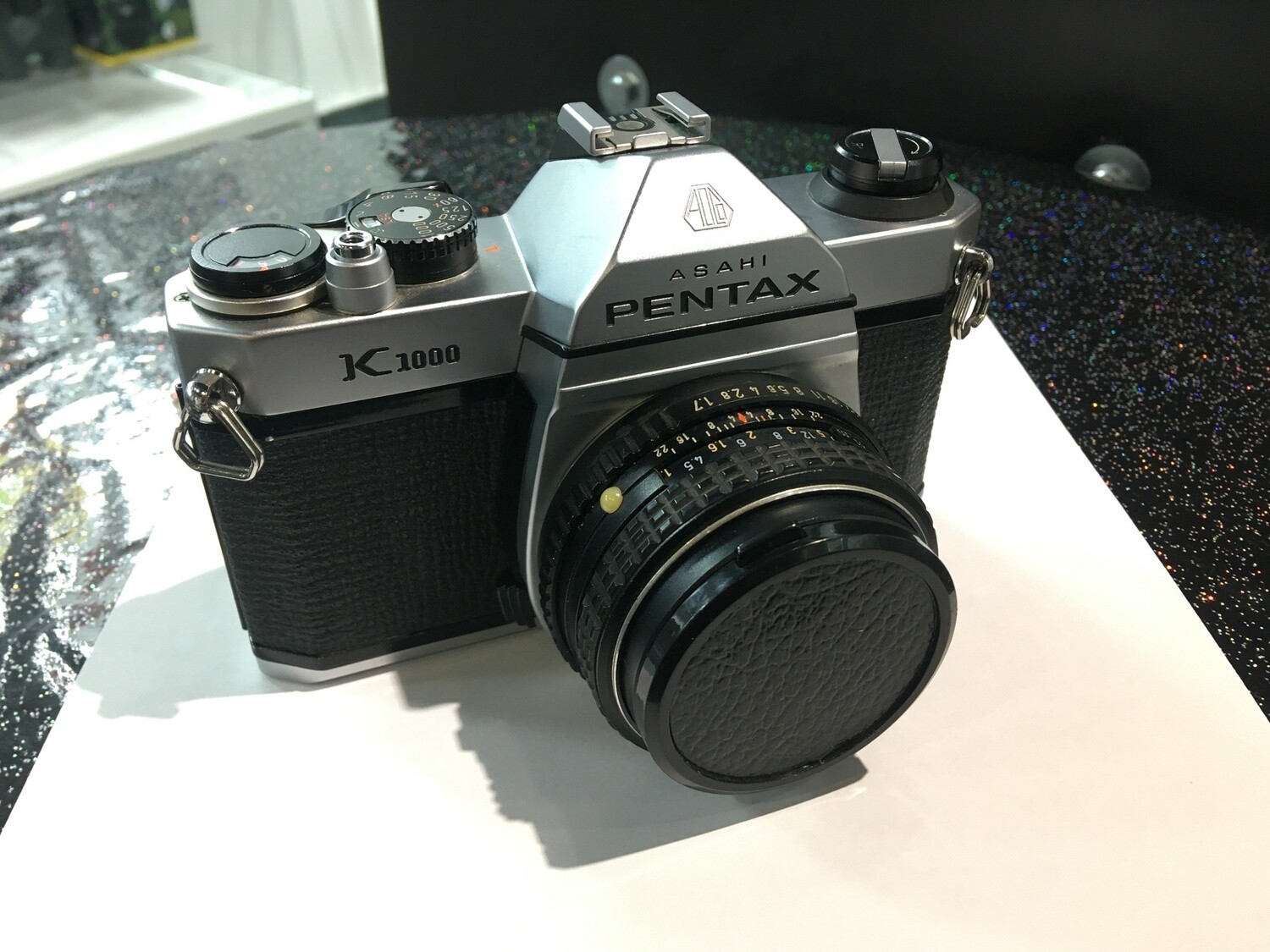USED - Pentax K1000 35mm Film SLR w/ 50mm f2 lens
The classic Pentax K1000 (or it's original full name - Asahi Pentax K1000) is an interchangeable lens, 35mm film, single-lens reflex (SLR) camera, originally manufactured for over 20 years by the Asahi Optical Co Ltd. from 1976 to 1997, originally in Japan, and later in Hong Kong & China. The K1000's extraordinary longevity makes it a historically significant camera; its inexpensive simplicity earned it an unrivalled popularity as a basic but sturdy workhorse. The Pentax K1000 eventually sold over three million units.
Lauched in 1976, it was the simplest member of Asahi Optical's excellent Pentax K-series of 35mm SLRs which included the Pentax K2, KM, and KX, all introduced in 1975, and the K2 DMD in 1976. All have the same basic chassis design, but with differing feature levels, electronics, and controls. The K1000 was actually the entry level KM with the self-timer & depth of field preview lever removed to save cost.
It uses a horizontal travel, rubberized silk cloth focal plane shutter with a speed range of 1/1000 second to 1 second, along with Bulb and a flash X-sync of 1/60 second. It is 91.4 millimetres (3.6 inches) tall, 143 mm (5.6 in) wide, and 48 mm (1.9 in) deep, and weighs 620 grams (21.9 ounces). The body was finished in black leather with chrome trim only, although the early production Pentax K1000 SE bodies had brown leather with chrome trim.
The introductory US list price for the K1000 body with SMC Pentax 55 mm f/2 lens was $299.50. In 1983, a K1000 with SMC Pentax-M 50 mm f/2 lens listed for $220; in 1988, the body was $210, but $290 with SMC Pentax-A 50 mm f/2; in 1993, the body was $263. The body was priced at $315 in 1994 and remained there until discontinued. Note that SLRs usually sold for 30 to 40 percent below list price.
At its launch, the K1000 was an all-metal, mechanically controlled, manual-focus SLR with manual-exposure control. It is completely operable without batteries - one A76 / S76, LR44 / SR44, 357 / 303 battery is used for the light metering information in the viewfinder. A centre-the-needle exposure control system using a galvanometer needle pointer moving between vertically arranged +/– over/underexposure markers to indicate the readings of the built-in full-scene averaging, cadmium sulfide (CdS) battery light meter versus the actual camera settings. There is a hot shoe for an electronic flash unit, and also a PC flash lead socket, of X type synchronisation.
Later, post-Asahi, Hong Kong & Chinese-made models had top and bottom plates made from plastic, painted to look like metal.
The K1000 has the Pentax K bayonet mount, and it accepts any other manual focus lens with the K mounts, which includes the SMC Pentax, SMC Pentax-M and SMC Pentax-A types. In addition, almost all lenses with the Pentax K-AF and K-AF2 autofocus lens mounts (introduced 1987 and 1991, respectively) also work in manual focus mode. The exceptions are Pentax's newest SMC-Pentax FA J (1997) and SMC-Pentax DA (2004) types which lack an aperture control ring, and K mount lenses designed for APS-C cameras; these can be mounted but with restricted functionality. There are also adaptors to allow older screw mount lenses to be used on K mount cameras (with limitations). In all, there are vast numbers of Pentax and third party lenses that can be used with the K1000 and other K mount camera bodies.
The K1000 gained popularity because of its low cost, and then for the reputation it won for ruggedness and reliability. Its spartan lack of certain features are regarded by some as a good feature in itself. In addition, for many years it was the camera recommended or mandated to students starting art or photography courses, because its manual controls forced users to learn about exposure
The three original K-Series cameras had relatively short production lives, because at that time the market trend was towards much smaller cameras, led by the Olympus OM-1, and away from heavy mechanical cameras - robust and reliable though they were. At the same time electronics was beginning to revolutionise camera design, and buyers were increasingly expecting automation in place of (or in addition to) manual metering. In 1976 Asahi therefore introduced the first of its small M-Series of 35mm SLRs and soon the M-Series had become the Pentax mid-range cameras. But, to salvage something from the K-Series, Asahi added features to the K2 to create the professional grade K2-DMD, and removed features from the KM to create the K1000 aimed at the lower end of the market; in both these markets the fashion for smallness was of less concern.

